Understanding Easefulness
Audio Introduction: Easeful Body
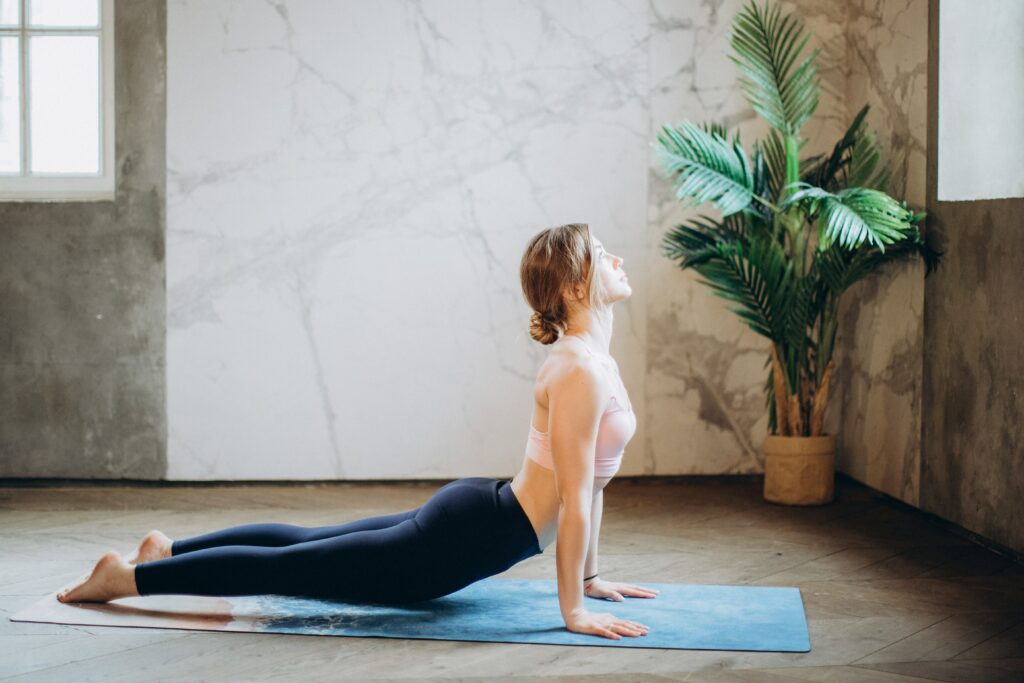
When examining the linkages between our lifestyles and overall well-being, the two primary areas of exploration are the mind and the body. Previously we explored the relationship between aerobic exercise and health, with the key being continuous rhythmic movement within your range of safety. This chapter is designed to bring even greater awareness of the physical body through yoga. As we begin to attune to the physical body through yoga postures, we will gain a deeper understanding of lifestyle factors that may need to be developed to promote a more harmonious body/mind dynamic.
The body is the grounding or physical expression of our genetic make- up, our lifestyle patterns, our thoughts and emotions, and our outlook on life. Through gaining a greater awareness of the physical body we can attune to the factors that may be underlying our current state of ease or dis-ease. By stretching, moving, listening to the body, and beginning to look after it, we can also find that our thoughts, emotions, lifestyle, and outlook on life are directly benefited. As neuromessengers are released through our mental activities, so too with physical stretching of the body are hormones and chemicals released into the body which then leave us feeling healthier and happier.
Working on mental enhancement but ignoring the body is like building a beautiful house without taking adequate time to establish a solid foundation, and this is reflected in many age-old sayings: “A healthy mind is a healthy body,””The body is the temple of the soul,” “An easeful body, a peaceful mind, and a useful life.”It is important to reacquaint ourselves with the body, attune to its needs, and begin to remedy blockages that exist through a regular routine of stretching. If we learn to look after the body and to listen to it, the quality of our life will improve beyond the time and energy we have spent on making the body easeful.
Our bodies reflect the stress and strain of daily concerns through the tensing and contracting of muscles. Whether it is because of a clenched jaw, or stiffness and tension in the shoulders and neck, we are all aware of feeling less than easeful at times. This is not necessarily a result of physical straining but may be from our thoughts, feelings, and situations we find ourselves in that we perceive as stressful.
Learning to stretch the body, attune to it, and lengthen muscles that are chronically tight as a result of stress will help to rebalance both the body and the mind. As the body loosens up, physiological changes will be taking place to allow the mind to benefit from this as well. Researchers have found that when people are asked to perform different simple movements (e.g. smiling, frowning), their bodies respond with physiological changes in areas such as breathing and heart rate. The body is not just a reflection of our thoughts and emotions; there is an interactive dynamic that also allows our physical expression and movement to affect our mental state of well being.
Reflecting on Daily Activities
Take a moment to reflect upon your weekly schedule. Relax by scanning your body mentally and releasing any tension. Think about your activities over a typical week. Ask yourself whether your body is becoming more flexible and supple as a result of these activities. Focus on specific regions-shoulders, neck, lower back, spine, knees, feet-and become aware of any muscular tension or in these areas. Do your daily activities enhance coordination, range of movement, and strength of the body? When you are ready, take out your journal and answer the following questions:
- On average, how many total hours a day do you spend sitting at a desk, in the car, at meals, or relaxing?
- How many hours do you spend sleeping?
- How much time do you spend exerting yourself through physical exercise?
- How much time do you spend slowly stretching the body for greater flexibility?
The answers to these questions will serve as a starting point for the development of a more easeful body. It is common for most people to spend a great deal of time sitting or sleeping, doing only limited physical exercise, and very little if any stretching. As a result, areas of the body can become stiff and painful, with a limited range of movement. Disease, poor blood circulation, and muscular weakness are commonly associated with this sedentary lifestyle. Simple movements that once were relatively easy-bending, lifting, twisting-become restricted. Organs of the body malfunction. Arthritis and muscular aches and pains can set in.
Through this reflection you may find that it is time to address these areas by incorporating a regular routine to regain an easeful body. Hatha yoga postures have been used for thousands of years to develop and maintain a flexible and healthy body, leading to a more peaceful mind and useful life.
Benefits of Yoga
Hatha yoga is a system of stretching the body that encourages awareness, is non competitive, is accessible to everyone, does not require endurance, is open to modification based on level of flexibility, reduces stress, requires no equipment purchase, and has been developed over thousands of years. The stretching postures work on the spine, making it supple and healthy, and thus promoting the maximum fresh blood supply to all the organs, glands, and tissues. By the gentle pressure of the postures the endocrine glands are toned, which results in both physical and psychological benefits.
Some other benefits of regular yoga practice include the maintaining and restoring of:
- Muscle strength and resilience
- Neuromuscular coordination
- Exercise tolerance
- Normal bowel function with regular elimination
- Musculoskeletal flexibility and joint range of movement
- Circulatory and respiratory efficiency including cardiac output, return of blood to the heart, and blood oxygenation
- Bone strength and structural integrity of joints
- Healthy lipid and cholesterol metabolism
- Sensitivity to insulin with resultant enhanced glucose metabolism
- Ability to respond constructively to challenges and stress
- Immune function, replacement of red and white blood cells
Preparing for Hatha Yoga
It is clear that the benefits of the yoga postures are numerous as long as there is regularity of practice with awareness not to strain in any of the postures. These postures are meant to be flowing, not bouncing, and done with a sense of inner attunement. When doing the postures, try to keep the mind centered on the breath and the stretch. Avoid getting caught up in mental distractions by always returning to the breathing.
If you have any injuries or health ailments, please go over this routine with your health practitioner before starting.
When preparing for your session:
- Wear comfortable, loose-fitting clothing that will not restrain your stretching in any way.
- Remove any jewelry or objects that may get in the way.
- Choose a location that is suitable in the sense that it is peaceful, clean, with good ventilation, carpeted if possible, and quiet.
- Lay out a mat, towel, blanket, or sheet on which to do your practices.
- If you have an old injury or are in any way concerned with your ability to do the postures, be sure to discuss these concerns beforehand with your health professional to see if they need to be modified in any way.
Exercise – A Yoga Routine
The routine illustrated here was brought to the West by Sri Swami Satchidananda and is taught as part of Integral Yoga.
It is a good idea to begin your practice by sitting for a moment with your eyes closed, and scanning the body. As you pass from the feet, gradually moving from part to part up to the head, mentally release any tension from the body. Become in touch with the body and how you feel at this point. Take this time to begin to bring the awareness within: let go of external sounds, sights, and smells, and focus your mind on sensations. Start with a full deep inhalation followed by a long relaxed exhalation, and repeat this deep breath twice.
It is also important to stretch and limber up the body with the sun salutation, which acts as a warm-up and general tonic for the entire system. A word about breathing: once you have learned the movements, aim to breathe smoothly in and out throughout the duration of each position. Eventually you may allow the pace to flow with no hesitation between each position. The whole sun salutation becomes one continuous movement.
Repeat this series two or three times. The tempo can be slow if you feel agitated or you can do the movements more rapidly want it to alert the mind and invigorate the body to relieve sluggishness.
Benefits: Improves and maintains flexibility. A general tonic for the entire system. Excellent for depression.
Sun Salutation or the 12-Part Movement
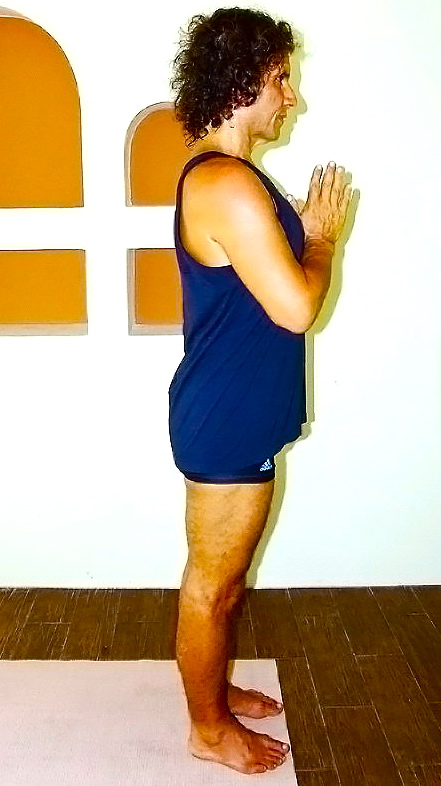
Position 1
Exhale. Stand up straight with your feet together. Bring your palms together in front of your chest.

Position 2
Inhale Lock your thumbs. Stretch put your arms in front of you. Watch your hands as you slowly raise your arms overhead. Bend backward a little from the hips as you stretch.
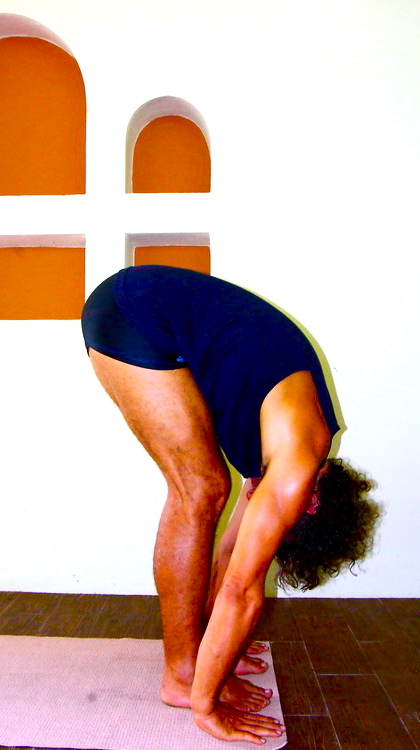
Position 3
Exhale. Fold forward from the hips as you stretch out and then down toward the floor, keeping the knees straight. Look back down toward the knees as the hands stretch in the direction of the floor.
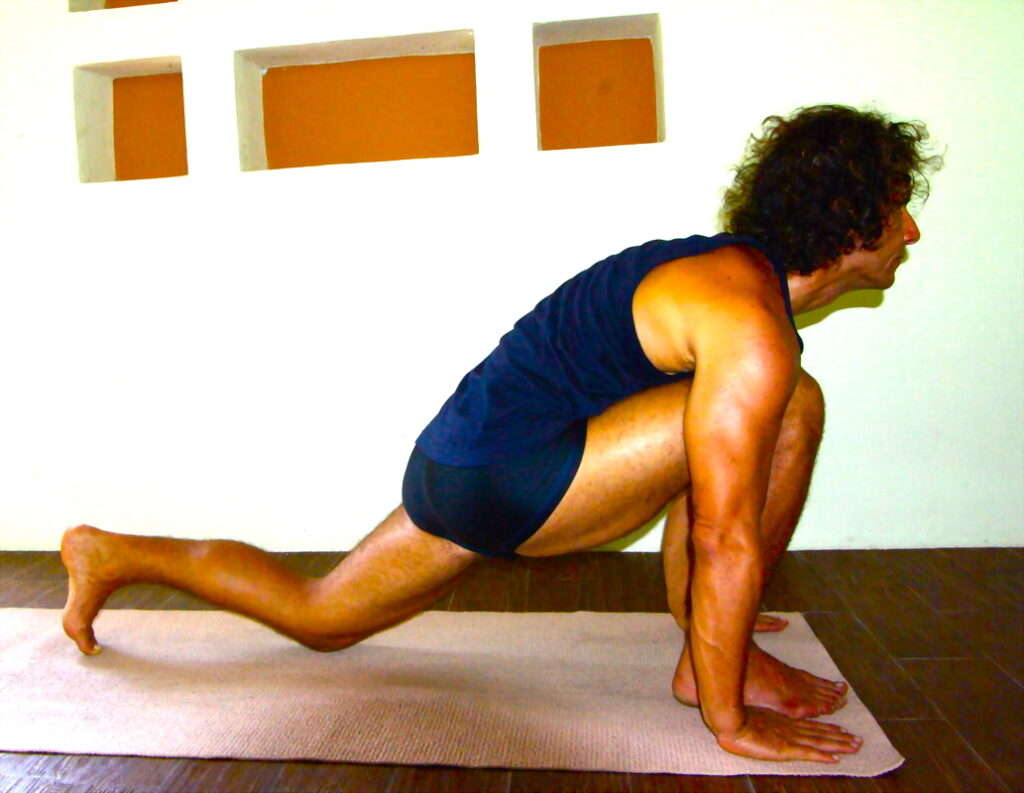
Position 4
Inhale. Bend your knees and place your palms alongside your feet with the fingertips and toes in a straight line. Stretch your left leg back, placing your left knee on the floor. Leave your right foot between your hands and bring your right knee to your chest. Look up.
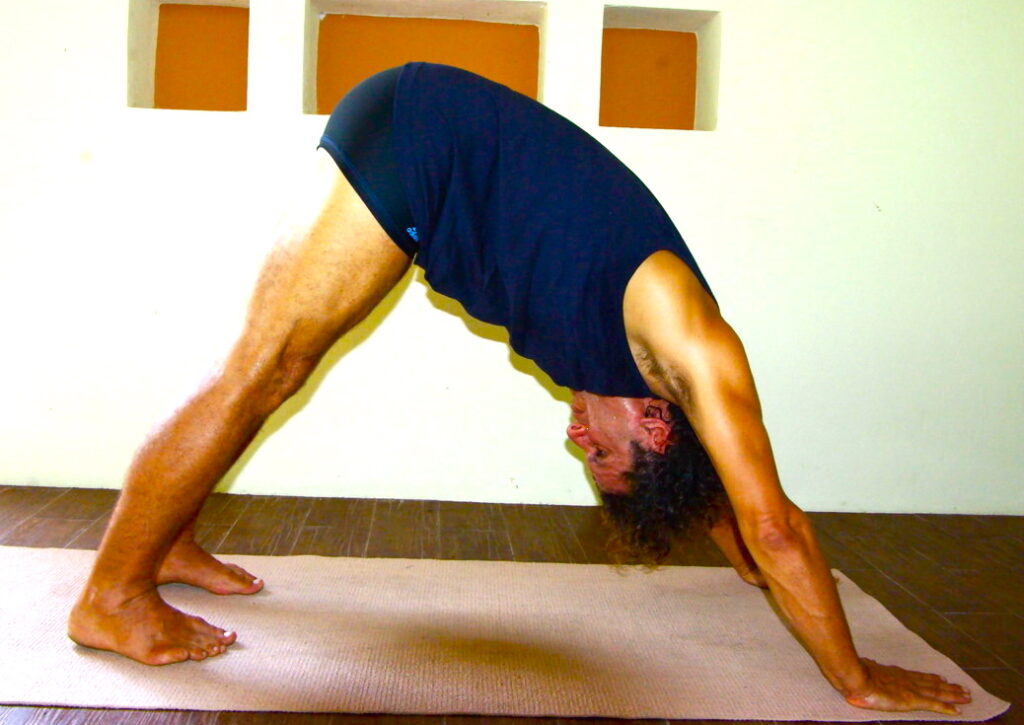
Position 5
Exhale. Take your right foot back to meet your left. Raise your buttocks so that your body now forms a triangle. Stretch your heels toward the floor and look at your feet.
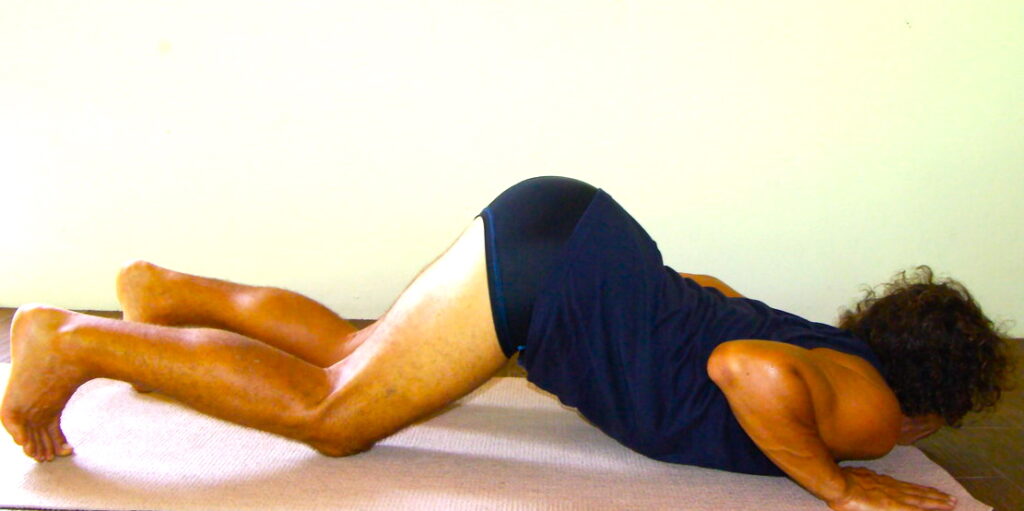
Position 6
Begin to inhale. Lower your knees, then chest and chin to the floor, leaving your pelvis slightly raised. Your palms are now beneath your shoulders, your elbows close to your body and pointing upward.
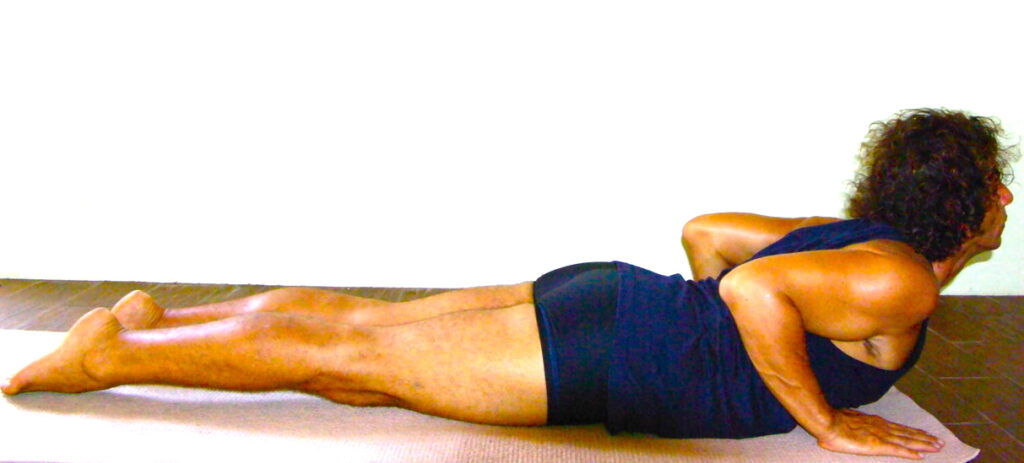
Position 7
Continue to inhale as you lower your pelvis to the floor. Stretch up your head, neck, and chest. Keep your elbows slightly bent and in toward your body.

Position 8
Exhale. Press down on your palms and feet to lift your buttocks, forming a triangle as before, with heels pressing down and head looking to feet.

Position 9
Inhale. Move your left foot forward between your hands, with your left knee touching your chest. The right leg is now stretched back, with your right knee on the floor. Look up.

Position 10
Exhale. Bring your right foot forward to meet the left. Bring your feet together and straighten your knees as you stretch down, as though touching your toes. Bend from your hips only as far as you feel comfortable. Head looking back to the knees.

Position 11
Inhale. Again lock your thumbs, stretch out toward the center and up toward the ceiling, and bend backward slightly as in position 2. Looking at the hands.

Position 12
Exhale. Slowly bring your palms together in front of your chest. Relax.

Back Stretch (Cobra Pose)
Lie on your abdomen. Place your palms on the floor beneath your shoulders, with your fingers pointing forward and your elbows raised and close to your body, as if you were going to do a push-up. Keep your legs together and your toes pointed.
Inhale. Stretch your chin forward and, without pushing down on your hands, slowly raise your head, then neck, then chest off the floor. Keep your pelvis on the floor, and try not to place any weight on your hands. Breathe normally.
At the beginning, hold this position for only a few seconds, repeating it twice. Exhale as you slowly roll down, first touching your chin, then your forehead to the ground. Turn your cheek to the side but leave your hands in place, and relax. At your own pace, gradually increase the time you spend in this position (up to a minute) and do it fewer times. The last time you come down, turn your cheek to the side, release your arms and legs, allowing the arms to rest alongside the torso, and spend a few seconds in the resting position on your abdomen.
Benefits: Excellent stretch for spine, back muscles, cranial nerves. Releases tension and aches from back and neck. Opens chest cavity, relieves constipation and gas.
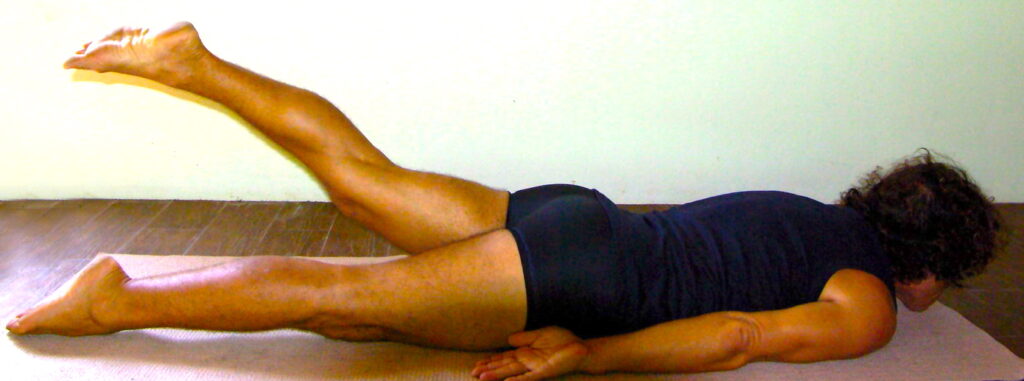
Leg Lift One (Half Locust Pose)
Lie facedown with your chin on the ground. Push your arms underneath your body, with your elbows close under your body and your palms facing your thighs. Keep your pelvis on your arms.
Inhale, straighten your right leg, then slowly raise it off the floor as far as you feel comfortable. Hold it in the air for up to 10 seconds while breathing normally, then slowly lower it down. Repeat with your left leg.
Do this twice with each leg.
Benefits: Excellent stretch for back, abdomen, pelvis.
Leg Lift Two (Full Locust Pose)
As shown, inhale, but this time stiffen the body, keep your chin on the floor, and raise both legs together a comfortable distance without bending your knees. Try to keep knees together and feet together. Breathe normally.
Repeat twice, holding for up to 10 seconds each time.
Benefits: Same as above. Also tones the sympathetic nervous system, improves liver function, and relieves the pain of lumbago.
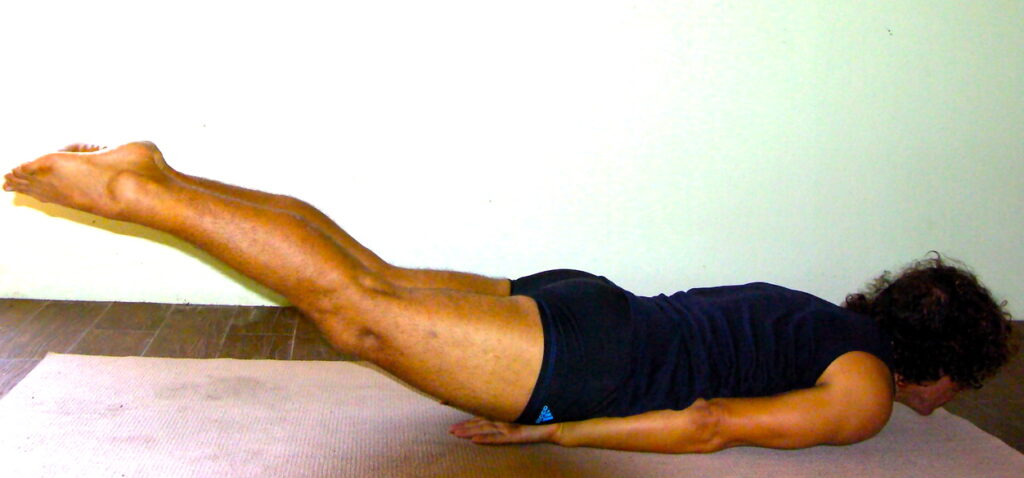

Backward Bend (Bow Pose)
Lie facedown. Bend the knees and bring the heels toward the buttocks. Reach and grasp the ankles or feet. Bring the forehead to Raise the head, then the chest and thighs, arching the back to allow the weight to balance on the abdomen. Keep the arms straight, the knees can be apart, and the awareness is on the entire spine. Come out of the pose in the reverse order. This is not to be practiced by those with a stomach or intestinal ulcer, or with high blood pressure or a hernia.
Benefits: Reduces abdominal fat and increases peristalsis of the bowels.
Forward Stretch One (Head to Knee Pose)
Sit on the floor and stretch out both of your legs in front of you. Bend your left leg and place the sole of your left foot on the inside of your right knee or thigh if you can.
Inhale, look up, lock your thumbs, and raise your arms overhead as far as you comfortably can.
Exhale, bending forward from the hips and keeping your back straight. Stretch out over the right leg as far as you feel comfortable. Then take hold of your right foot, calf, or whatever you can comfortably reach. Allow your head to relax. Breathe normally.
Hold this position for up to 10 seconds, then repeat with your other leg. Repeat two or three times with each leg. With regular practice, gradually increase the time you can spend in this position and do it fewer times. Then relax on the back.
Benefits: Tones abdominal organs, activates kidneys, liver, pancreas, and adrenal glands. Stretches hamstrings and loosens the hip joints.

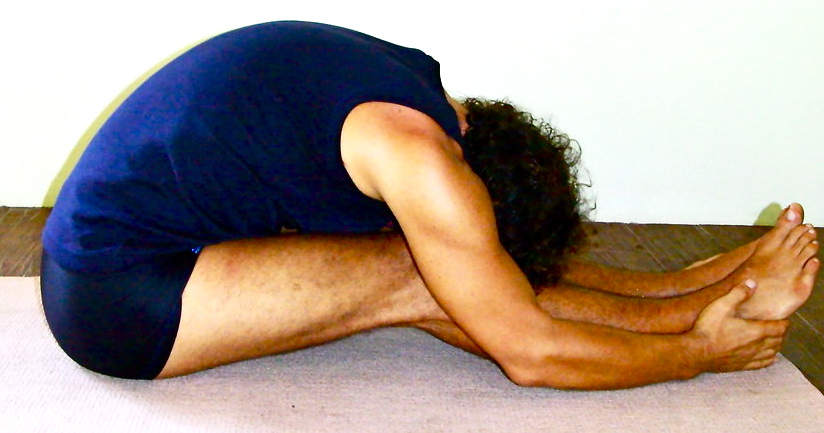
Forward Stretch Two (Full Forward Bend Pose)
This pose is the same as the head-to-knee pose, but instead of bending one leg, you stretch out over both legs together.
Stretch your arms up over your head, sitting firmly on your buttocks, back and neck straight. Then, folding forward from the hips, stretch out over both.
Once you have extended as far forward as feels comfortable, slowly lower your hands down on the feet or legs, allowing the head, neck, and shoulders to relax.
If you want to go deeper into the pose, raise the upper body with an inhalation, and, as you exhale, extend further out over the legs and lower down.
Repeat twice, holding for 10 seconds. Gradually increase the time in the pose (up to 30 seconds) and come into it just once as you become more comfortable with it through regular practice.
Benefits: Stretches back and buttock muscles. Excellent for the bladder, prostate, and lumbar nerves.
Shoulder Stand (Modified I & II)
Do only these modified versions have high blood pressure, neck or shoulder injuries, back pain, or if you have had problems with the other postures.

Modified I:
Lie on your back and elevate your legs by resting your feet on a chair seat. Maintain this position for two or three minutes, less if you become uncomfortable.
Benefits: Excellent for the blood circulation.
Modified II:
If you have none of these challenges and would like to go one step further, allow your calf muscles to also rest on the chair seat then, grasping hold of the chair seat with both hands, place the feet on the top of the back support of the chair allowing your thighs or buttocks to be supported fully by the front edge of the chair seat with both hands holding the chair seat firmly. If comfortable, tuck the chin into the chest and lift the feet off the back of the chair with the knees as straight as possible. Breathe normally. Hold only as long as you feel steady and comfortable. When you are ready to come down, slowly lower your legs back onto the chair, then place your feet on the seat with your buttocks returning to the floor. Lower the legs back to the floor releasing your hands from the chair and roll over onto one shoulder. Then sit for a moment to regain your balance. Avoid doing inverted postures during time of menstruation.
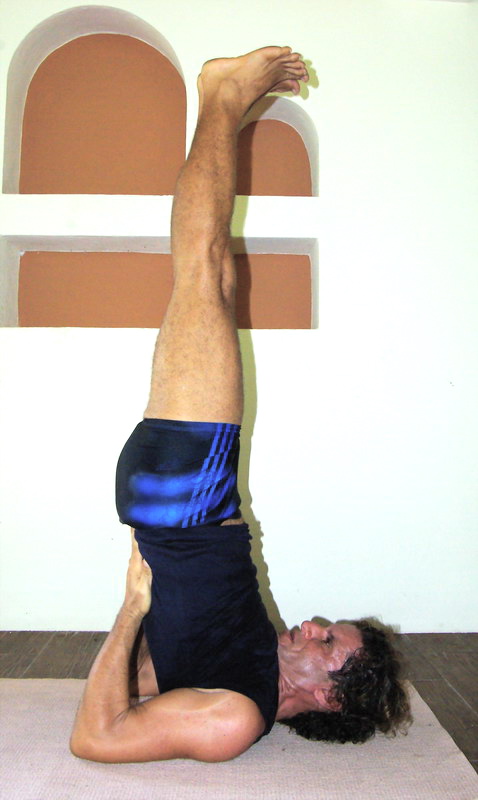
Shoulder Stand (Regular)
Lie on your back with your feet together and your arms alongside your body, palms down. Be aware of the back of the neck area and remove any hair or obstacles behind the neck. Try not to cough, swallow, or sneeze while in the pose; if you need to do so, come out of the pose in the reverse order.
Inhale, straighten your legs and lift them up to a 90-degree angle. Press on the palms and swing the legs slightly overhead or parallel to the floor and bring the hands to your lower back for support. (You may find that you need to bend the knees in order to raise your legs over your head.) Gradually straighten your legs to a vertical position, bringing your chin and chest close together. Breathe normally. Hold for only as long as you feel comfortable and steady, feeling free to reposition the hands, bringing them closer to the spine and further down toward the shoulder blades to give you more support and to keep you straight.
When you are ready, slowly lower your legs over your head again so that they are parallel to the floor, transfer your forearms to the floor, bring your trunk down slowly, then lower your legs slowly to the ground. If your abdomen is not strong enough to allow this, just roll down slowly with control, in whatever way is most comfortable for you.
Benefits: Excellent for the circulatory, digestive, and nervous systems. Stimulates the thyroid gland, helping to regulate the body’s metabolism.

Chest Extension (Fish Pose)
Lie on your back. Bring your legs together and grasp the sides of your thighs. Resting your weight on your elbows, raise your head and trunk to a half-seated position. Arch your back, thrusting out your chest. Lower your head and place the top of your head on the floor. Your weight should be balanced between the top of your head, your elbows, and your buttocks. Have a slight smile on your face to relax any tension in your jaw. Hold for one-third of the time that you held the shoulder stand.
To come down, shift your weight to your elbows, straighten your neck and back, then slowly lower to the floor. Whenever you do the shoulder stand, always follow it with the fish pose as it helps to balance the shoulder stand.
Benefits: Opens up the chest cavity and oxygenates the lungs. Useful for people suffering from asthma or bronchitis. Massages neck and shoulders. Excellent for improving posture.
Half Spinal Twist
Sit on the floor and extend your left leg straight out in front of you. Cross your right foot over your left knee, placing the sole of your right foot flat on the floor. Sit up straight. Bring your right knee close to your chest. Now extend your arms in front of you, lock your thumbs and twist to the right.
Unlock your thumbs and place your right hand on the floor behind you, close to your body, with your fingers pointing away from you. Place your left arm between your trunk and your right knee (on the outside of your right knee), and press your knee to the right.
Reach around your right knee with your left hand and take hold of the outside of your left leg or the instep of your right foot. Slowly twist your head and trunk to the right and look over your right shoulder. After 15 to 60 seconds, slowly unwind and do the same pose on the other side.
Benefits: Excellent for liver, spleen, kidneys, and adrenal glands. Strengthens the back muscles.
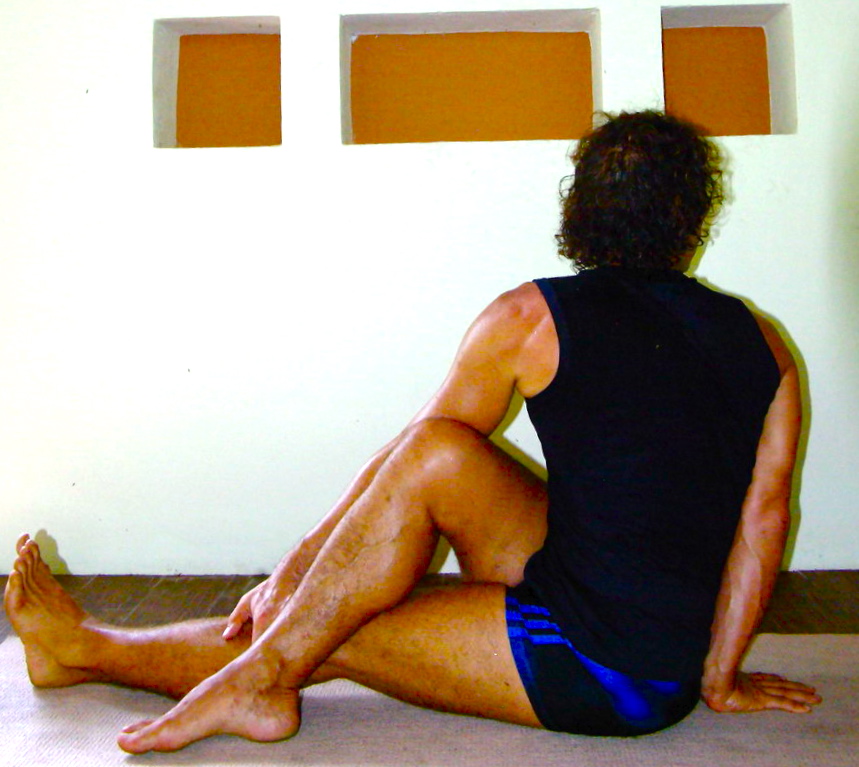
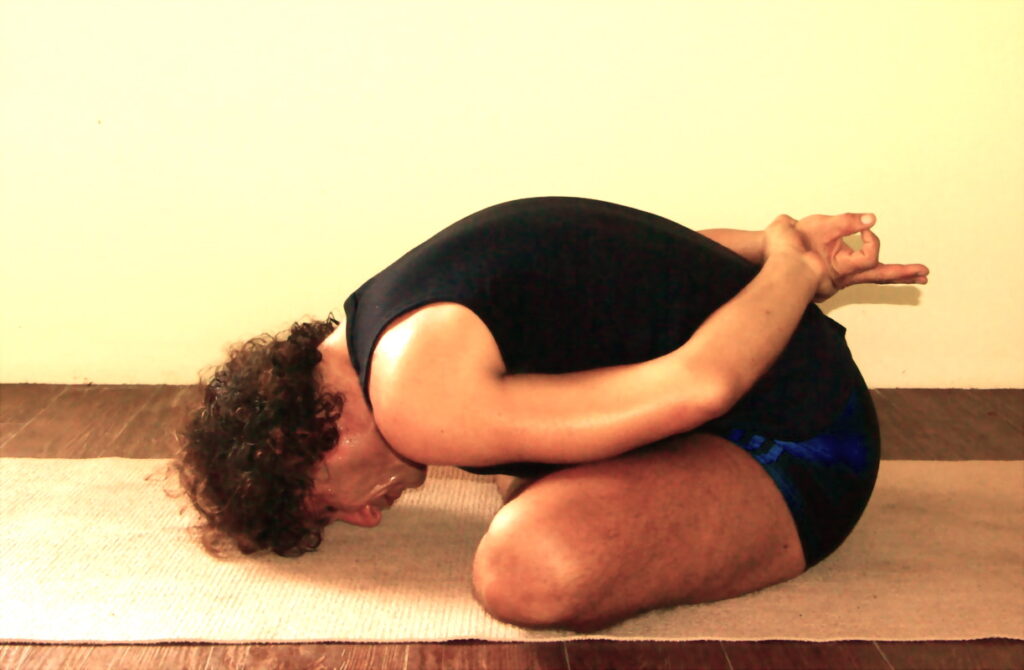
Forward Stretch (Yogic Seal)
Sit in a comfortable seated position with your legs crossed and eyes closed. Take both hands behind your back and grasp your right wrist with your left hand. Sit up straight and inhale deeply.
Exhale, bending forward from your hips. Come forward as far as is comfortable and allow the head to lower and with practice rest on the floor. You may wish to spend several minutes relaxing into the position, letting go of tension in your neck, back, and shoulders.
To come out of the pose, extend your chin, inhale, then return to a seated position, keeping the back straight, and release the hands. Just sit for a moment with the eyes closed feeling the balancing effect.
Benefits: Massages the abdominal organs. Tones the entire nervous system.
Massage
Another useful tool for improving flexibility and relieving muscular distress is massage. Through massage you can release tension that may have been stored in specific areas of the body for years. While the variety of massage techniques available may seem a bit confusing at first, it is just a matter of experiencing what feels comfortable for you. A complete deep body massage provides the following benefits on a physiological level:
- Improves muscle tone
- Increases the flow of nutrients to the muscles
- Cleanses the body of toxins by promoting the flow of lymph
- Dilates the blood vessels and promotes circulation
- Relieves muscle tension
In addition to providing numerous physical benefits, massage works on a psychological level. Through releasing tension, you begin to feel more comfortable with your body. This in turn promotes a more joyful and peaceful approach to life.
Daily Routine
When doing the yoga postures you should allot at least 20 minutes, in combination with the other practices that follow, to go through the series of movements. Look over your schedule and determine the best time of the day for you to do these practices regularly. Morning is ideal as yoga is a great way to start the day and if for some reason you cannot do it, you still have the rest of the day to fit it in. Never take the attitude that it is all or nothing. Even if on a particularly busy day you have only a few minutes to spend on stretching, it is far better to do a few sun salutations than nothing at all.
Know that it is through regular practice, with a sense of commitment and inner attunement, that the benefits discussed earlier will come. Do not compare yourself with others. Remember never to strain. Be accepting of where you are at each moment with no judgment as to progress being made. Your daily schedule will ensure that over time the body will derive all the benefits of these movements, and the mind will become increasingly peaceful.
If you choose to hold postures for longer periods of time as you become more flexible, ensure that you do not eliminate part of your routine, as each pose balances the next and provides a particular benefit. Also, if you hold the postures for longer periods of time and increase the overall time of your routine, do not reduce the time dedicated to other components of the program. The integrated nature of HELP is crucial to its effectiveness.
Helpful Hints for an Easeful Body
- Join a yoga class
- Use a HELP audiotape or video to guide you through the yoga routine
- Try other methods of gentle exercising such as tai cho or qi gong
- Have massages to keep the body supple
- Participate in a yoga retreat
Further Reading
Mandelkom, Philip (ed). To Know Your Self: The Essential Teachings of Swami Satchidananda, Integral Yoga Publications, Buckingham, Virginia, 1978.
Saraswati, Satyananda. Asana, Pranayama, Mudra, Bandha, Bihar School of Yoga, Monghyr, Bihar, India, 1977.
Satchidananda, Swami. Integral Yoga Hatha, Holt, Rinehart & Winston, New York, 1975.
Schatz, Mary Pulig. Article in Yoga Journal, May/June 1990.
Sivananda, Swami. Health and Hatha Yoga, Divine Life Society, Sivanandanagar, India, 1985.